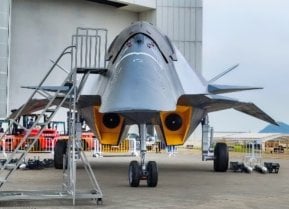The NGAD Fighter Problem Explained in 2 Words
Secretary of the Air Force Frank Kendall doesn’t seem quite ready to give up on the NGAD just yet, stating back in June that “We are looking at the NGAD platform design concept to see if it’s the right concept or not. We’re looking at whether we can do something that’s less expensive and do some trade-offs there.”
Too Expensive?: The U.S. Air Force’s Next-Generation Air Dominance (NGAD) program faces scrutiny over its projected $300 million per aircraft cost, prompting discussions on whether a cheaper version is feasible. General David Allvin has proposed a "Light Fighter" concept emphasizing modularity, digital engineering, and open systems architecture as a cost-efficient alternative.
-Critics, however, argue that such an approach may compromise NGAD’s performance and relevance. Despite concerns, Secretary of the Air Force Frank Kendall is exploring trade-offs to reduce costs.
-The NGAD program’s future remains uncertain as the Air Force balances cutting-edge technology with budgetary constraints.
Can the U.S. Build a Cheaper Version of the NGAD Fighter Jet?
If the U.S. Air Force’s sixth-generation fighter jet program is too expensive to merit continuation, can a cheaper version of NGAD be built?
My first instinct is saying “Only if it’s an NGAD In Name Only.” But let’s do some further digging and see if a more cost-efficient NGAD is more than a mere pipe dream.
The Light Fighter
As I noted in my October 15, 2024, article on the NGAD’s financial trials & tribulations, the current estimated price tag is running at $300 million per aircraft, which makes the Lockheed Martin Skunk Works F-35 Lightning II fifth-generation stealth fighter’s $80 million per unit cost look like a Dollar General store special by comparison.
Those staggering cost projections are causing the Air Force brass to wince, and accordingly no less than the Air Force chief of staff himself, Gen. David Allvin, is proposing an alternative known as the “notional Light Fighter concept,” which he introduced this past July. Allvin’s vision for the light fighter has the following desirable traits: open systems architecture; modular design; digital engineering; and 3D-printing/additive manufacturing.
This would mark a major paradigm shift in the U.S. Air Force’s approach to combat aircraft acquisition, i.e., a focus on adaptability and modularity instead of ruggedness. (This would certainly embody the spirit of the early twentieth-century airpower theorist Gen. Giulio Douhet’s dictum that “Flexibility is the key to airpower.”) Maybe it wouldn’t meet the originally envisioned criteria for NGAD, but it would still technically be a sixth-generation warbird. So, from a purely semantic standpoint, the “NGAD” label could be conveniently transferred to the light fighter concept.
Any other options?
In an October 4, 2024, article for Defense News titled “Can the Air Force make its next-gen fighter jet cheaper than the F-35?,” Stephen Losey quotes Heather Penney, a retired F-16 pilot and senior resident fellow at the Mitchell Institute for Aerospace Studies, who casts a rather pessimistic and skeptical cloud upon the notion of building the NGAD on the cheap:
“I think it would be extremely challenging, if not unrealistic, to get the kind of capability and performance that they need in NGAD [for] less than the cost of an F-35. I’m concerned at the way that Secretary Kendall and the senior leadership have been talking about NGAD, because it feels a lot like they’re boiling the frog, that they’re getting people ready for a program cancellation … If you go too cheap, it’s not going to be relevant for the things that they need it to be able to do.”
That said, Penney isn’t all gloom-and-doom on the prospect, noting that one potential avenue would be to increase the modularity of NGAD (which sounds a tad like the chief of staff’s light fighter concept), so more elements such as sensors and processors could be developed separately and later bolted on. To quote Bill Murray in the classic early 1990s comedy “What About Bob?,” “Baby steps, baby steps…”
Where to from here?
For his part, Secretary of the Air Force Frank Kendall doesn’t seem quite ready to give up on the NGAD just yet, stating back in June that “We are looking at the NGAD platform design concept to see if it’s the right concept or not. We’re looking at whether we can do something that’s less expensive and do some trade-offs there.”
And as anybody who’s read Hedrick Smith’s Pulitzer Prize-winning bestseller The Power Game: How Washington Works can attest, pricey Pentagon programs die hard. Time will tell.
About the Author: Christian D. Orr
Christian D. Orr is a Senior Defense Editor for the National Security Journal (NSJ). He is a former Air Force Security Forces officer, Federal law enforcement officer, and private military contractor (with assignments worked in Iraq, the United Arab Emirates, Kosovo, Japan, Germany, and the Pentagon). Chris holds a B.A. in International Relations from the University of Southern California (USC) and an M.A. in Intelligence Studies (concentration in Terrorism Studies) from American Military University (AMU). He has also been published in The Daily Torch, The Journal of Intelligence and Cyber Security, and Simple Flying. Last but not least, he is a Companion of the Order of the Naval Order of the United States (NOUS).
Image Credit: Creative Commons.


